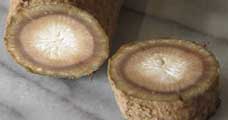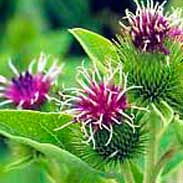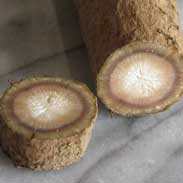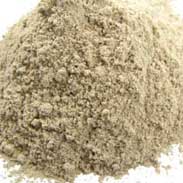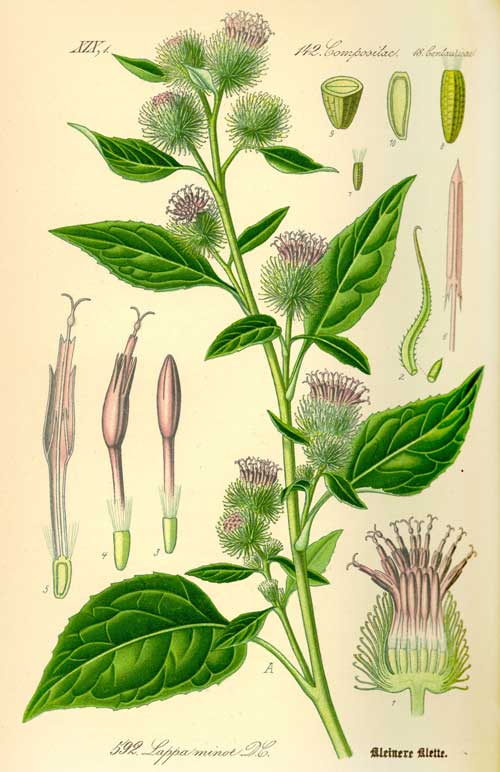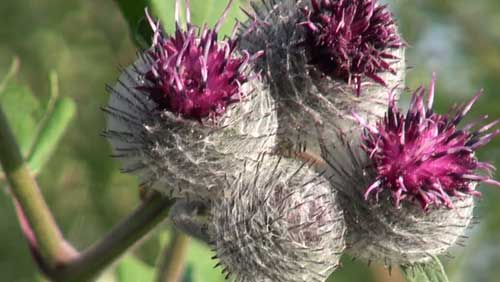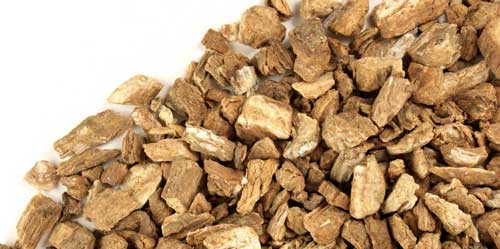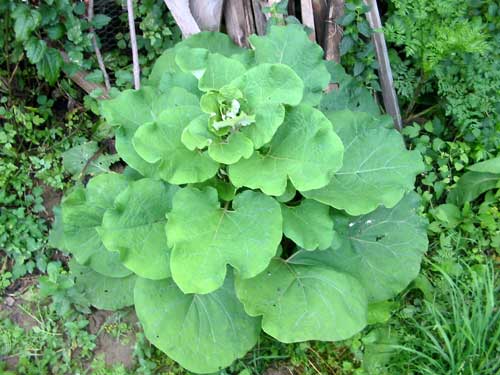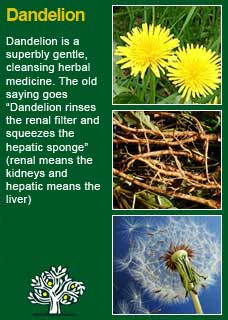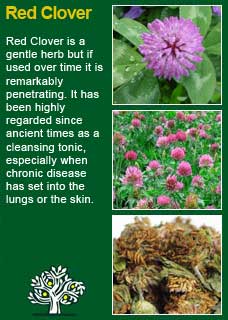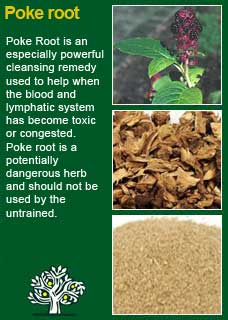
|
|
||||
| Our Pages ABOUT CONSTITUTIONAL MEDICINE
|
The roots of Burdock, a herb that lives for two years in which time it grows to 2 metres tall with leaves up to half a meter across, the roots usually harvested in the Autumn of its first year or the Spring of its second.
Burdock is known as one of the best cleansers in all of herbal medicine. It is especially identified with helping chronic skin conditions such as acne, eczema, boils, psoriasis and cysts. Thomas Bartram writes Burdock is 'one of the most powerful and reliable of blood tonics of herbalism' he says that 'persistence with low doses is more favourable than larger, over short periods' and goes on to recommend it for arthritis, gout, rheumatism, boils, styes, cystitis and many skin diseases. John Heinermann writes 'Burdock is perhaps the most widely used of all blood purifiers, among the best the herbal kingdom has to offer for this... it is the most important herb for treating chronic skin problems'. M Grieve writes 'the name of the genus, Arctium, is derived from the Greek arktos, a bear, in allusion to the roughness of the burs, lappa, the specific name, being derived from a word meaning 'to seize' WM Cook writes 'This is the burdock plant so annoying to the farmer; with its great coarse leaves, purplish flowers in numerous thistle-like heads, and long, tapering roots. The roots are succulent, difficult to dry, and of an unusual sweetish taste. It is best when gathered in early spring, and sliced into thin pieces. Unless very quickly and thoroughly dried, it will mildew. It yields its property readily to water and diluted alcohol. The root is mainly relaxant and demulcent, it acts slowly and mildly upon several of the secreting organs, as the kidneys, skin, and bowels. This secures from it a gentle alterant action, of use in cutaneous, scrofulous, and scorbutic affections, particularly where there is an irritable condition of the system. Its action on the kidneys and bladder is available in irritable conditions of these organs, to the bowels, it merely favors a soft and natural openness. preparations of it require to be pretty strong, and given freely; though half a pint of a decoction three times a day, as some writers advise, would be ridiculous. The agent requires to be used several weeks, to secure its full benefits' TJ Lyle writes 'the root is a soothing demulcent tonic alterative. It slowly and steadily influences the skin, soothes the kidneys and relieves the lymphatics. It is of great importance in all skin diseases. It is very soothing to the mucous membrane throughout and is hence valuable in irritated conditions, its soothing character is also valuable in rheumatism' From King's Dispensatory, 1898: Skin diseases are conditions in which Burdock has gained a reputation. It has been particularly praised in psoriasis, its use being long-continued to produce good results. Chronic erysipelas, milk crust, and various forms of eczema have been cured with it. Burdock is of marked value in catarrhal and aphthous ulcerations of the digestive tract. A favourable action is obtained from it in dyspepsia (indigestion) When a cachectic condition of the blood is manifest, and where an alterative is demanded it relieves broncho- pulmonic irritation and cough. Rheumatism, both muscular and articular, when previous inflammations have left no structural alteration, are benefited by Burdock Early Chinese and Indian physicians used Burdock as an immune remedy and it was highly regarded to help against colds, flu, throat infections and pneumonia. The German Abbess/herbalist St Hildegard of Bingen wrote of Burdock for the treatment of cancerous tumours and it has been widely used by a great many people in the fight against cancer for thousands of years. The Swiss inventor, George de Mestral, out walking in the early 1940's, became curious about the thorny 'burrs' of Burdock that attached themselves to his dog's fur. On examining them under the microscope he realised that he could formulate a working copy; the result was 'Velcro'
~ Burdock has been used extensively around the world as a cancer treatment and several studies show that substances in the herb do in fact have anti-tumour activity (Chan, Y. S., Cheng, L. N., Wu, J. H., Chan, E., Kwan, Y. W., Lee, S. M., Leung, G. P., Yu, P. H., and Chan, S. W. A review of the pharmacological effects of Arctium lappa (burdock). Inflammopharmacology. 2011;19(5):245-254) ~ Researchers have identified a compound (arctigenin) in Burdock as 'an inhibitor of experimental tumour growth'. and studies have shown that the herb decreased mutations in cells exposed to cancer-causing chemicals (Morita, K., Kada, T., and Namiki, M. A desmutagenic factor isolated from burdock (Arctium lappa Linne). Mutat.Res 1984;129(1):25-31) ~ Arctiin from Burdock was found to lower the concentration of tumor necrosis factor-alpha and interleukin-6 and promote collagen synthesis in human monocyte dendritic cells and dermal fibroblasts in vitro (Knott, A., Reuschlein, K., Mielke, H., Wensorra, U., Mummert, C., Koop, U., Kausch, M., Kolbe, L., Peters, N., Stab, F., Wenck, H., and Gallinat, S. Natural Arctium lappa extract improves the clinical signs of aging skin. J Cosmet.Dermatol. 2008;7(4):281-289) ~ Inhibition of HIV-1 virus infection has been demonstrated in vitro . Several lignans are now under investigation as antivirals (particularly anti-HIV)) (Yang L, Lin S, Yang T, and et al. Synthesis of anti-HIV activity of dibenzylbutyrolactone lignans. Bioorganic Medicinal Chem Lett 1996;6:941-944) German researchers have found that Burdock contains substances (polacetylenes) that kill disease causing bacteria and fungi. This may partly explain Burdock's traditional reputation for the treatment of ringworm and several common bacterial infections of the gut and urinary tract (Schulte, K. E., Rucker, G., and Boehme, R. [Polyacetylenes as components of the roots of bur]. Arzneimittelforschung. 1967;17(7):829-833) ~ The authors, titles and the 'where-and-when' published of over 50 further studies and articles on Burdock are listed in a PDF found here
The Toxicology of Botanical Medicines identifies Burdock as a uterine stimulant which would suggest that it should not be used during pregnancy but please note that there are no reports of adverse reactions in the literature and this is likely to only be a theoretical concern. Burdock might reduce platelet aggregation by inhibiting platelet activating factor so, theoretically, taking burdock with anticoagulant or antiplatelet drugs might increase the risk of bleeding due to decreased platelet aggregation. Some of these drugs include aspirin, clopidogrel (Plavix), dalteparin (Fragmin), enoxaparin (Lovenox), heparin, ticlopidine (Ticlid), warfarin (Coumadin). Note that these concerns are theoretical only, no evidence of adverse reactions or drug interactions has been published and so long as it used with care Burdock can be safely used by young and old and at any stage of life when it is needed.
For some years now, against this proven and safe way of herbalism, there has been a rising tide of excessive caution and scare-mongering in many parts of the world. The same authorities that, not so long ago, decried herbal medicines as ineffectual, have now taken up a different adversarial position; that they are dangerous substances that should only be prescribed by Doctors, who of course have zero training in them. Unfortunately, the same unnecessary fear and worry has crept into many natural health websites and popular publications on herbs. Herbs that we have safely used for thousands of years, that have no reports of adverse reactions in the medical literature despite widespread use by millions of people, are suddenly described as contraindicated because of something that should have been seen as completely unimportant, or at the utmost a merely theoretical concern, such as a laboratory study on one of the herb's constituents to use an all too common example. I wonder sometimes if the writers of such articles feel that the herb will be more deserving of respect if it is thought to be a little bit dangerous, in other words more like a drug than something that has simply come out of the earth and been used by ordinary people for generations beyond count. There is just so much misinformation about herbal medicine on the internet now. Ludicrous claims and cautions abound in equal measure; it seems like one group are trying to make money out of the public whilst the other are busily trying to scare them off. I have to believe that the kind of reader who takes the time to read pages on herbs that are as extensive as this one is much less likely to be swayed by marketers or misinformers. I hope that you will keep your wits about you if you get conflicting opinions from people who have never really got to know these herbs, who have never worked with them, or learned how to use them safely and effectively. I want to remind you that the reason that herbs can never be patented and owned by any individual or corporation is because they are, and always will be, the People's medicine. They belong to all of us and it is my great hope in sharing this work that you will learn how to use them wisely for yourself, and the people you care for. Be safe, but do not be afraid.
I have a tremendously high regard for Burdock and could not imagine being able to work successfully with many of the chronic health problems I see without its sure support. I have especially found that small but regular doses of Burdock used over long time frames (e.g. several months) can work exceptionally well to help people with poor health and bad skin look and feel much better. I, and a number of my colleagues whose opinions I value, instinctively feel that Burdock cleans the blood through the kidneys and that this is a herb that works best when people keep well-hydrated whilst they are using it. Conversely, and I'm sure this is because it has such a strong and steady cleansing action in the body, I have seen that if people are taking Burdock in medicinal levels but then let themselves get dehydrated then they can start feeling pretty bad! Dosage is critical with Burdock just as it is with so many of our potent cleansing herbs. Too much could be too taxing on the kidneys; too little and the essential process of clearing the body of its excess debris will not reach a satisfactory outcome. I don't think there is an exact rule here and it must be borne in mind that the strength of different medicines can greatly vary according to the quality of their starting materials and the process by which they are extracted. For the tincture that we make from organic Burdock root in our clinic I generally work with around 2 or 3 mls a day, perhaps half that for a more sensitive individual, rarely any more. The tea of Burdock is also excellent to use and again I think that if it were going to be used over a reasonable time frame that a moderate dose of just 2 or 3 grams a day of the cut, dried root will work well. That said, a short and high-dose treatment with Burdock and Dandelion by decoction has sometimes been used to get the ball well and truly rolling on some particularly bad cases of acne in the past. This use of it is written up in the article on acne here Good cleansing is a real art in medicine, not too hard, not too soft. A herb that can shift skin conditions that have been stuck for years is doing deep things in the body. Burdock is quite forgiving if you overdo it up to a point but if a person is feeling it to be too strong in their system and that they are having too strong a cleansing reaction to it after being on it for at least a week then I think it is time to show respect and back off. This subject is covered in more depth in the article on detoxification found here If you who are reading this are studying herbal medicine then you might want to acquire some Burdock and take a small dose of its tea or tincture with a quiet and attentive mind so you can experience it for yourself. I think you will find that it reliably produces a rather distinctive 'action' that will give you an appreciation of the herb beyond the limit that an academic understanding can bring you to. Further to this, if you would like to learn more about the ancient art of pulse testing, a simple but powerful way to ask the intuitive intelligence of the body for its responses to a herb by feeling the pulse whilst giving a tiny dose by mouth, read here The pairing of Burdock with Dandelion root creates a remarkable depth of blood and tissue cleansing that I and many other herbalists have had the opportunity to observe in practice, a recipe from practice shared below. Burdock also works particularly well with the blood purifier Red Clover and the potent lymph cleanser Poke Root. These two herbs work especially well as a pair, they are very safe and suitable for longer term use if needed. They work by deeply cleansing the liver and the blood and, in the experience of this herbalist, there has not been a single case where there wasn't at least some significant improvement from using them if taken in good amounts for at least 2 or 3 months. Generally, it will be most convenient when wanting to use them over a longer time-frame, to take them in tincture form, where a daily dose of approximately 4-6 mls of the two herbs combined is sure to convey their therapeutic benefit. If things are quite bad, and particularly if we want to get the internal cleansing process moving more strongly in the beginning of the treatment process, it can be very effective to use the Dandelion and Burdock in a high-dose decoction for a short while. In the evening take approximately 8 grams of the dried, cut root of each herb (16 grams in total), place in a saucepan and pour over approximately 3 cups of freshly boiled and still-hot water. Allow this to soak overnight and then in the morning bring it up to the boil, then turn down and allow to vigorously simmer for around 5-10 minutes. You should be left with about 2 cups after the simmering and some water absorption into the roots and you then strain this decoction into some kind of container, e.g. a drink bottle or a thermos. It is up to you whether you drink it hot or cold, it will work just as well either way. These two cups are an entire day's dose but should not be taken in one sitting. Divide into at least two doses or drink throughout the day. Most people find it quite palatable and many say they enjoy it! Note that this the above method is very potent, high-dose herbal medicine and you must carefully listen to your body for how long to stay with this. For some people two weeks is ample, others will want it for less time and others can take it a longer. Trust your instincts, if you feel intuitively good about taking this medicine but then one day just find that the taste and feel of it repels you, then take a break. Maybe try again later to see if your feelings have changed.
Much of the information here about the traditional uses of Burdock is consistent with the model of thinking whereby one may treat problem A with plant B. There is value in this approach, especially in how it helps us pass on useful knowledge to one another, but it falls short in one vital area which is that people are not all cut from the same cloth! Something that works brilliantly for one person may do less for another -- why is this? Part of the reason is that people vary in their constitutions as to whether they are either hotter or cooler and, at the same time, either dryer or damper. This useful and rather fascinating subject is introduced further here Another big part of using the right herb when it is most needed comes from understanding the need to treat what is going wrong for the person that had led up to their getting a health condition. In this light,Burdock can particularly offer its benefits when a cleansing action is needed in the 'cycle of healing' more about that here
Please understand that I cannot advise you, including on products or dosage, without seeing you in person in my clinic but for ideas
on how you might find a good herbalist in your area read here |
|
|
|
© 2011 R.J.Whelan Ltd
